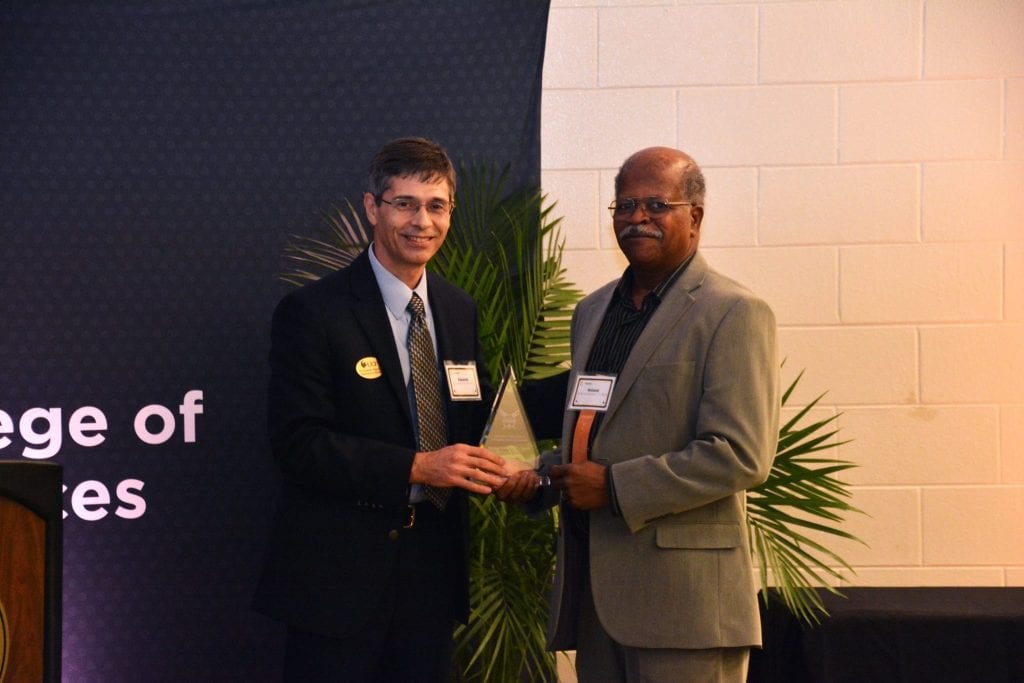Physics Degree Leads to Career in Missiles, Aerospace

Eduardo Mucciolo, Ph.D., Physics Chair, and Roland Williams, accepting his award.
When Roland Williams first stepped foot on UCF’s campus nearly 50 years ago, the library was the tallest, most prominent building around. There was almost nothing else in sight as Williams pulled up to the school, but he was excited for the opportunity to move closer to his family and explore his interests in physics.
“I found I had the notion to really dig into physics,” he said. “It was a general interest of mine. I thought I had an aptitude for science and math. I wanted to know more.”
Prior to 1963, education in the Central Florida area was inaccessible. But UCF changed that, providing the surrounding area with a school and a chance to learn.
“I was part of one of the first classes,” Williams said. “I registered in 1968. It was a great opportunity. Of course, the university started out with only 1200 to 1500 students.”
Those students formed a small, but supportive, community. Williams lived on campus during his time at school, to be close to the social activities on campus. He often took charge and proposed his own events, too.
“I was amazed that many were agreement when I proposed things at the time,” he said. “It was a surprise to me in a sense. People were open-minded and willing to work with me for what we were trying to do, which was a number of things. We needed money to have speakers come.”
Williams helped bring Reverend David Abernathy, a leader in the Civil Rights Movement, to campus. He also met with UCF’s first president, Charlie Millican, Ph.D., and helped organize experiences for students to meet with professors. Williams even met his wife at UCF.
“We had a real campus atmosphere,” he said. “Many of us living on campus knew each other. It was so small, it was a village.”
That village feeling was not simply reserved for extracurricular events. It applied to academics, as well. If the university only had 1200 students to start, the physics program was even smaller.
“The physics department chair, if I recall, was Dr. Rexroad, the very first chair of the department,” Williams said. “He eventually had three other professors come on that I worked with and another one came on later, but that was it in 1968.”
This gave Williams a chance to connect with professors intimately and get to know their projects.
“I had a professor, Dr. Lytle, in the math department who taught me a class in calculus,” he said. “He gave me a lot of encouragement and I got to know him a little bit more. He worked at Martin Marietta. That was the biggest hire of engineers and scientists around here.”
Williams eventually made his way to Martin Marietta, but not before taking a position as a physical science teacher at Oviedo High School when he graduated.
“I got the job knowing what was going on in the industry,” he said. “While the school opportunity was great, at the same time, I had people inside Martin Marietta working to try and find me a position.”
He became an electronics engineer at General Dynamics after he finished teaching. The industry was still a bit shaky, but soon after that, his hard work, determination and contacts at Martin Marietta came through.
“Eventually I found an opportunity at Martin Marietta, which is where I wanted to work,” Williams said. “Everyone did- either there or at the Cape. I preferred it there.”
He then worked there for 11 years, primarily as a structural analyst for missiles and weapons systems. But he wanted to challenge himself and his career, so he decided to move to Georgia and pursue a career at Rockwell International.
“It was a good move for me,” he said. “I felt my career needed a push and they gave me an opportunity to work independently on bigger projects.”
While there, he continued to analyze military weapon systems. Eventually, he became a senior lead engineer, in charge of the structural analysis of several major missile programs such as the AGM-130 Missile, the HELLFIRE Missile and others found on fighter aircraft or helicopters.
Boeing bought Rockwell out, and Williams found himself once more in Florida. Finally, Williams was able to transition into a great highlight of his career: the space industry.
“The idea that you were going to space was very intriguing,” he said.
He worked within the NASA Systems Group of Boeing, continuing to complete structural analysis, but this time with bigger aerodynamic loads, higher temperatures and much faster speeds in his calculations.
“I was doing the same type of work, but in a different arena,” Williams said. “It’s very similar within the industries. It’s the fundamentals you know from physics, really, applied to a new industry. Once there, you learn the environment.”
Williams retired from Boeing in 2014, after a long career in structural analysis and following advancements in both military and commercial aircraft. He helped resolve a side of body fitting issue on the side of the 787 aircraft, allowing Boeing to receive flight clearance and saving them millions of dollars per plane.
“Focus on becoming the best you can be in your field,” Williams suggests to students. “If you have good roots from UCF, it will show. Physics was an ideal background that I carried with me.”
